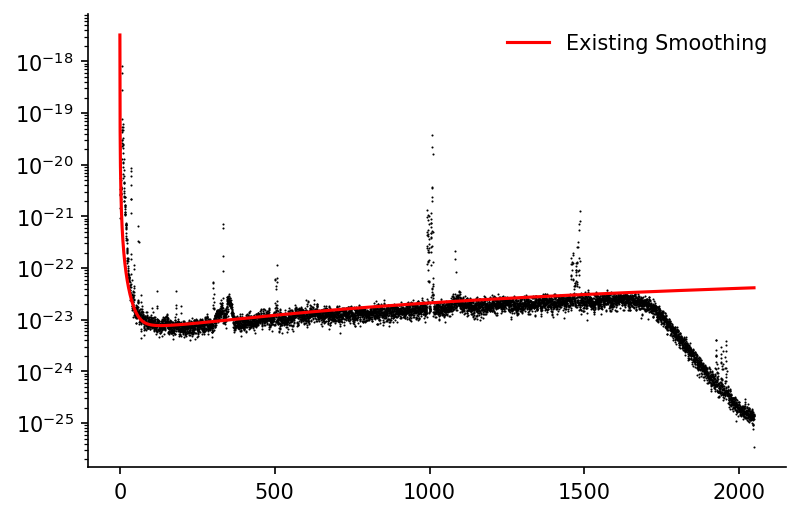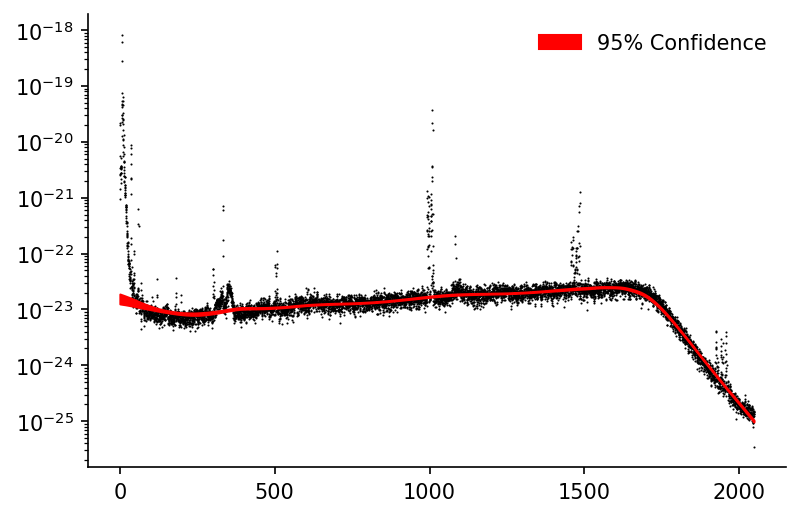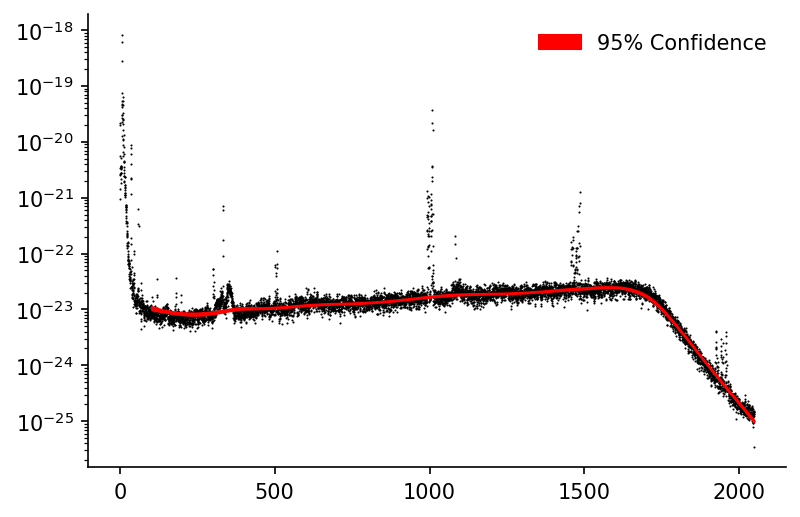Bootstrapped LOWESS for LIGO Estimation Confidence Intervals¶
This notebook outlines how to use the moepy library to generate confidence intervals around the LOWESS estimates, using the famous LIGO gravitational wave data as an example.
N.b. I have no expertise of signal processing in this particular context, this is merely an example of how LOWESS confidence intervals can be used to limit the domain of your prediction to where you have greatest certainty in it.
Imports¶
import numpy as np
import pandas as pd
import seaborn as sns
import matplotlib.pyplot as plt
from moepy import lowess, eda
Loading Data¶
We'll start by loading the LIGO data in
df_LIGO = pd.read_csv('../data/lowess_examples/LIGO.csv')
df_LIGO.head()
| Unnamed: 0 | frequency | L1 | H1 | H1_smoothed |
|---|---|---|---|---|
| 0 | 0 | 2.38353e-18 | 2.21569e-20 | 3.24e-18 |
| 1 | 0.25 | 1.68562e-18 | 2.01396e-20 | 2.6449e-19 |
| 2 | 0.5 | 1.24297e-21 | 5.5185e-21 | 9e-20 |
| 3 | 0.75 | 6.6778e-22 | 2.54612e-21 | 4.48443e-20 |
| 4 | 1 | 6.80032e-22 | 3.33945e-21 | 2.67769e-20 |
Baseline Fit¶
We'll quickly plot the observed data alongside the smoothed estimate provided in the raw data
fig, ax = plt.subplots(dpi=150)
ax.scatter(df_LIGO['frequency'], df_LIGO['H1'], color='k', linewidth=0, s=1)
ax.plot(df_LIGO['frequency'], df_LIGO['H1_smoothed'], color='r', alpha=1, label='Existing Smoothing')
ax.set_yscale('log')
ax.legend(frameon=False)
eda.hide_spines(ax)

LOWESS Fit¶
x = df_LIGO['frequency'].values
y = np.log(df_LIGO['H1']).values
df_bootstrap = lowess.bootstrap_model(x, y, num_runs=500, frac=0.2, num_fits=30)
df_bootstrap.head()
| x | 0 | 1 | 2 | 3 | 4 | 5 | 6 | 7 | 8 | 9 | ... | 490 | 491 | 492 | 493 | 494 | 495 | 496 | 497 | 498 | 499 |
|---|---|---|---|---|---|---|---|---|---|---|---|---|---|---|---|---|---|---|---|---|---|
| 0 | -52.5227 | -52.724 | -52.4039 | -52.5183 | -52.5897 | -52.4715 | -52.5306 | -52.4727 | -52.5534 | -52.5212 | ... | -52.5536 | -52.6798 | -52.508 | -52.554 | -52.4346 | -52.6022 | -52.355 | -52.5031 | -52.5719 | -52.5057 |
| 0.25 | -52.5235 | -52.7245 | -52.4049 | -52.5192 | -52.5904 | -52.4723 | -52.5314 | -52.4737 | -52.5542 | -52.522 | ... | -52.5544 | -52.6804 | -52.5088 | -52.5547 | -52.4356 | -52.6029 | -52.3561 | -52.504 | -52.5727 | -52.5066 |
| 0.5 | -52.5244 | -52.725 | -52.4059 | -52.5201 | -52.5912 | -52.4732 | -52.5322 | -52.4746 | -52.555 | -52.5228 | ... | -52.5553 | -52.681 | -52.5096 | -52.5555 | -52.4365 | -52.6037 | -52.3573 | -52.5048 | -52.5735 | -52.5075 |
| 0.75 | -52.5252 | -52.7256 | -52.4069 | -52.521 | -52.5919 | -52.4741 | -52.533 | -52.4755 | -52.5559 | -52.5236 | ... | -52.5561 | -52.6816 | -52.5105 | -52.5562 | -52.4375 | -52.6044 | -52.3584 | -52.5057 | -52.5743 | -52.5084 |
| 1 | -52.5261 | -52.7261 | -52.4079 | -52.5218 | -52.5927 | -52.4749 | -52.5338 | -52.4764 | -52.5567 | -52.5244 | ... | -52.5569 | -52.6822 | -52.5113 | -52.5569 | -52.4384 | -52.6051 | -52.3595 | -52.5065 | -52.5751 | -52.5093 |
Using df_bootstrap we can calculate the confidence interval of our predictions, the Pandas DataFrame quantile method makes this particularly simple.
df_conf_intvl = lowess.get_confidence_interval(df_bootstrap, conf_pct=0.95)
# Plotting
fig, ax = plt.subplots(dpi=150)
ax.scatter(df_LIGO['frequency'], df_LIGO['H1'], color='k', linewidth=0, s=1, zorder=1)
ax.fill_between(df_conf_intvl.index, np.exp(df_conf_intvl['min']), np.exp(df_conf_intvl['max']), color='r', alpha=1, label='95% Confidence')
ax.set_yscale('log')
ax.legend(frameon=False)
eda.hide_spines(ax)

We can see that we capture the middle and higher frequencies fairly well but due to the smaller number of data-points in the low frequency region the LOWESS fit is unable to model it as well. The frac could be decreased to improve this but then comes at the cost of processing more inaccurate estimates in the other regions. One way to address this could be to introduce an option where frac can be varied for each local regression model.
For now we'll just limit our prediction to the domain where the confidence interval is 'reasonable', we'll start by calculating the 95% confidence interval.
s_95pct_conf_intvl = (df_bootstrap
.quantile([0.025, 0.975], axis=1)
.diff()
.dropna(how='all')
.T
.rename(columns={0.975: '95pct_pred_intvl'})
['95pct_pred_intvl']
)
s_95pct_conf_intvl
x
0.00 0.404673
0.25 0.404049
0.50 0.403448
0.75 0.402822
1.00 0.402187
...
2047.00 0.077741
2047.25 0.077827
2047.50 0.077913
2047.75 0.077999
2048.00 0.078085
Name: 95pct_pred_intvl, Length: 8193, dtype: float64
We'll now define the 'reasonable' confidence interval threshold, in this case using the value that icludes 95% of the values.
x_max_pct = 0.95
# Plotting
fig, ax = plt.subplots(dpi=150)
hist = sns.histplot(s_95pct_conf_intvl, ax=ax)
y_max = np.ceil(max([h.get_height() for h in hist.patches])/1e2)*1e2
x_max = s_95pct_conf_intvl.quantile(x_max_pct)
ax.plot([x_max, x_max], [0, y_max], linestyle='--', color='k', label='95% Coverage')
ax.set_ylim(0, y_max)
eda.hide_spines(ax)

We'll then only plot our confidence interval when it's in this 'reasonable' range
conf_intvl_idxs_to_keep = (s_95pct_conf_intvl<x_max).replace(False, np.nan).dropna().index
# Plotting
fig, ax = plt.subplots(dpi=150)
ax.scatter(df_LIGO['frequency'], df_LIGO['H1'], color='k', linewidth=0, s=1, zorder=1)
ax.fill_between(conf_intvl_idxs_to_keep, np.exp(df_conf_intvl.loc[conf_intvl_idxs_to_keep, 'min']), np.exp(df_conf_intvl.loc[conf_intvl_idxs_to_keep, 'max']), color='r', alpha=1, label='95% Confidence')
ax.set_yscale('log')
ax.legend(frameon=False)
eda.hide_spines(ax)
